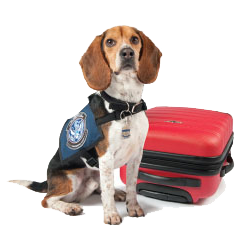Travelers Crossing Canadian Land Border into the United States with Meats, Poultry, Milk, Dairy, Eggs, or Pet Food/Treats
[ Back ]
The United States restricts or prohibits the entry of many agricultural products, which can carry foreign pests and diseases that harm American agriculture and our environment. A major pest or disease outbreak could mean higher grocery bills, shortages of certain foods, and devastating losses for our farmers and ranchers. Help us keep American agriculture healthy by following the guidance on this page about products you may want to bring into the United States.

Are you traveling from Canada by Land? Find out which meat, poultry and pet food products that you CAN and CANNOT bring back to the U.S. from Canada's land border. Air travelers should refer to the guidance listed below.
Meats, Poultry, Milk, Dairy, Eggs, Pet Food and Pet Treats you CAN and CANNOT bring into the U.S. from Canada when crossing at a land border
- CANADA: Meats (fresh, chilled, frozen)
-
No import permit or documentation is required for travelers to bring back up to 50 pounds of meat (total) of the following types of fresh (chilled or frozen), cooked, cured or dried meats from Canada: beef, bison, veal, sheep (lamb, mutton), goat, swine and camelid. Travelers can also bring in personal-use amounts of foods containing beef, veal or bison.
Personal-use amounts of cervid meat (deer, elk, moose, caribou), including hunter-harvested cervid meat, is allowed if the traveler presents the Customs and Border Protection officer with evidence that the product is cervid meat, such as a valid hunting license or commercially prepared labels found on unopened packages or other official documents.
There is a limit of 50 lbs. per vehicle.
- CANADA: Poultry Meat
-
No import permit or documentation is required for travelers to bring back personal-use amounts of poultry meat from Canada.
There may be temporary restrictions for travelers to bring back personal-use amounts of poultry meat from Canada. Please visit Imports: Animal and Animal Products and view the “temporary restrictions” section.
There is a limit of 50 lbs. per vehicle.
- CANADA: Pet Food, Chews and Treats
-
Travelers may bring back certain pet food, chews and treats from Canada under certain conditions. The items must be in unopened retail packaging. If the items are raw (not shelf-stable without refrigeration), dehydrated, freeze-dried, or sun-dried, then the items must be labeled as a product of Canada or the U.S.
If you are traveling back from Canada by land, there is a limit of 50 lbs per vehicle.
If you are traveling back from Canada by air, the limit is 20 lbs per family.
- CANADA: Dairy Products (Milk, Cheese, etc.)
-
Travelers may bring back milk and other dairy products from Canada with proof of Canadian origin: package label; written documentation; proof of travel (passport or travel itinerary); origin of flight; receipt of sale; or a certificate.
- CANADA: Eggs or Egg Products
-
No import permit or documentation is required for travelers to bring back personal-use amounts of eggs or egg products from Canada.
There may be temporary restrictions for travelers to bring back personal-use amounts of poultry meat from Canada. Please visit Imports: Animal and Animal Products and view the “temporary restrictions” section.
- CANADA: Animal Trophies
-
Trophies from Canada may enter with documentation that proves country of origin, including a bill of lading; certificate of origin; invoice; document on official letterhead prepared by the manufacturer, seller, outfitter, Provincial government, Tribal Nation, shipper; or an official certificate issued by a veterinarian representing the Canadian national government certifying the country of origin. The trophies must be fully finished or receive special processing upon entry.
How Do I Declare Agricultural Items?

USDA-trained dogs help sniff out plants and animal products in luggage and carry-on items on international flights. Make sure you include any agricultural items on your Customs Declaration Form (select form below). This form provides Customs and Border Protection officials with basic information about who you are and what you are bringing into the United States, such as agricultural and wildlife products and whether you have visited a farm prior to traveling to the United States. When you declare, a U.S. Customs and Border Protection official can check your items. This is the only way to be certain that your items are free of plant pests and animal diseases.
Customs and Border Protection (CBP) Forms